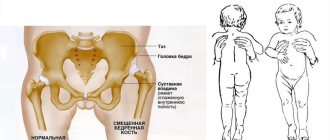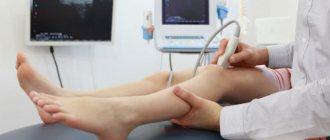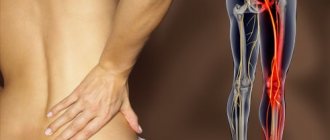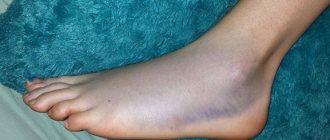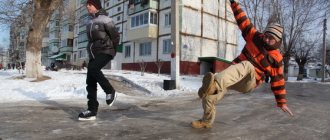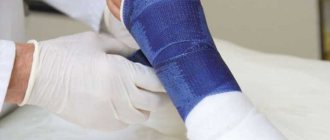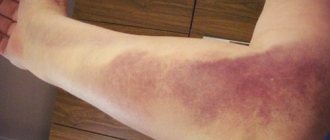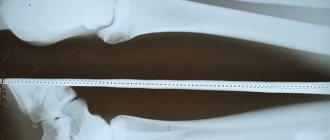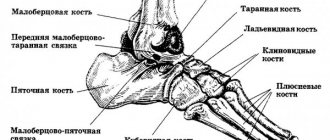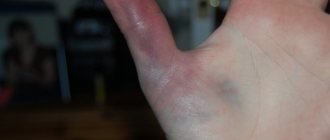Rehabilitation after an ankle fracture implies the return to the previous functionality of tissues destroyed or weakened by the injury and its consequences. In a cast, the load on the muscles almost completely stops, which leads to their atrophy and, as a consequence, a deterioration in the supply of nutrition and oxygen to all adjacent tissues of bones and joints.
The ankle joint has a complex structure. Any of the three bones can be injured, be it the fibula, tibia or talus, but in any case this will lead to rupture of muscle tissue and ligaments.
The symptoms of ankle injuries are minimal, so it is almost impossible to detect serious changes in the joint without photographs.
Main tasks of the recovery period:
- reverse the processes of muscle atrophy and destructive changes in blood vessels;
- restore mobility to the joint;
- prevent stagnation of fluids in the reconstructed limb;
- increase motor activity of the joint.
Anatomical features
According to its structure, the ankle joint is a trochlear joint: between a kind of “fork” of two ankles, a block of the articular surface of the talus is inserted. Stability is provided by numerous ligaments: they are arranged in several layers, powerful and durable.
Fig.1. Ankle structure
Freedom of movement is somewhat limited: the joint allows the foot to flex and extend with good amplitude only in one plane.
The ability to move the foot to the right and left is small, but the supporting ability allows it to cope with loads reaching ten times the body weight. True, sometimes even such a safety margin is not enough.
Mechanism of injury
Fractures of the ankle joints occur under the influence of multidirectional forces:
- Axial force perpendicular to the sole (causing wedging of the talus between the ankles).
- Excessive bending (flexion) and extension (extension).
- Turning inward (supination) and turning outward (pronation).
- Rotation of the foot inward (inversion) and outward (eversion).
If a sufficiently large amount of energy is applied in any of these directions, the joint structure may fail and break.
Varieties and types
The classification of ankle fractures is quite complex. Separately classified:
- Fractures of the fibula (outer malleolus).
- Tibial (inner malleolus).
- Damage to the tibiofibular syndesmosis.
- Talus.
Each of these categories has sub-items. In case of injuries, they are combined and rarely occur in isolation. Knowing all the nuances of each type of fracture and understanding the mechanism of injury allows you to eliminate the damage as completely and effectively as possible.
Usually, ankles break off: external (lateral, - the process of the fibula) or internal (medial - part of the tibia). Both can break at once.
Rice. 2. a. displaced fracture of both ankles; b. fracture of the ankles and posterior edge of the tibia.
The peculiarity of such fractures is that sometimes the ankles seem to be torn off from the bones of the leg: when the leg is twisted, strong ligaments may not break, but pull the ankle along with them, tearing it off completely, or causing a breakage and displacement of a small fragment of the bone.
Severe high-energy injuries may not be limited to the ankles and are accompanied by fracture of the articular surface of the tibia.
The talus fractures noticeably less frequently. But if it is damaged, intra-articular fragments may occur. They do not always produce pronounced symptoms and often end in the development of false joints.
We have to deal with fracture-dislocations: when one or both ankles of the leg are broken off, they lose the ability to fix the block, the talus dislocates and shifts, complicating treatment.
Fig3. A. fracture of the outer malleolus, rupture of the syndesmosis and deltoid ligament, subluxation of the foot outward. b. fracture of the talus.
Such injuries are dangerous due to disruption of the blood supply to bone tissue, which causes aseptic necrosis (talus bone) and greatly complicates the work of doctors.
A frequent complication is rupture of the external and deep ligaments and displacement of bone fragments.
Types of treatment
Treatment of pain after a fracture of the knee joint or ankle is used to:
- relieving or reducing the intensity of pain in the knee or ankle;
- eliminating the etiological factor of pain (if any);
- protection of damaged tissues;
- restoration of lost functions;
- preventing relapse of the disease.
IMPORTANT! Regardless of the cause of pain, the first step is to relieve it to improve the patient’s condition.
Types of treatment used in traumatology and orthopedics:
- conservative treatment;
- operational.
If it is not possible to seek medical advice, pain can be relieved using alternative medicine. But it should be borne in mind that traditional medicine cannot completely cure the cause of pain, but only slightly reduces its manifestations.
Conservative
In the basic treatment of pain syndrome, as well as in the treatment of destruction of the knee joint and ankle, the following groups of drugs are used:
- non-steroidal anti-inflammatory drugs;
- chondroprotectors (for damage to the articular surface);
- local analgesics.
If the cause of pain is the addition of infectious agents, antibiotics are added to the basic therapy. Read more about the treatment of severe pain in the knee joint in this article.
Non-steroidal anti-inflammatory drugs include:
- Diclofenac sodium . The amount of the drug depends on the intensity of the pain syndrome. The average dosage is 75–150 mg, 1–2 times a day. The course of treatment is 5–7 days. The drug is contraindicated for children under 6 years of age.
- Indomethacin , dose 25–60 mg, 2–3 times a day. If necessary, the dose can be increased, but not more than 200 mg per day.
- Ibuprofen . The special thing about ibuprofen is that it can be given to children. Dosage for children – 10 mg per 1 kilogram of body weight. For adults, 400–600 mg per day for 2–3 doses, the maximum dose should not exceed 1200 mg. Ibuprofen can also be taken for pain after a bruise. Read more about ways to eliminate swelling and pain after a child’s knee injury in this article.
IMPORTANT! NSAIDs should be taken with caution by people who have erosive and ulcerative diseases of the gastrointestinal tract.
Chondroprotectors are prescribed to protect cartilage tissue from wear and delay arthrosis or ankylosis. The main drugs in this group include:
- Artra : take 1 tablet 2 times a day, the course of treatment is three weeks.
- Theraflex : you need to take 1 capsule 3 times a day, the course of treatment is 4 weeks.
Among local analgesics, novocaine or lidocaine patches are very often used. For treatment, it is necessary to stick a patch in the area where the pain is located and leave it for 12 hours. You cannot use more than one patch in 1 day.
Conservative treatment methods also include diet and diet. It is necessary to reduce the load on the sore knee or ankle to the maximum. It is also not recommended to consume alcoholic beverages, sour foods and meat in large quantities.
Conservative therapy also includes the use of physiotherapy:
- Exercise therapy (physical therapy) . Pain syndrome can develop due to a long period of muscle and joint immobility. Therefore, early initiation of physical therapy can eliminate pain. For more information on how to develop the knee joint after an anterior cruciate ligament rupture, fracture or bruise, read this article.
- Electrophoresis and UHF . These methods help well, but only in combination with drug therapy. It is necessary to undergo 9–12 courses of electrophoresis to achieve the desired result.
Useful video
From the video you will learn exercises for knee recovery after injury.
Rehabilitation of an injured knee. Kazakevich Vitaly
Operation
Surgical intervention is indicated in the following cases:
- ankylosis of the joint or formation of a false joint;
- sclerosis and calcification of the joint capsule, cartilage tissue;
- incorrectly performed reposition or osteometallosynthesis operation for the first time.
The purpose of surgery is to eliminate traumatic factors and sclerotic elements that impede joint movement.
In difficult cases with complete destruction of the knee joint, doctors recommend installing an artificial joint.
If the pain is associated with persistent swelling or advanced hemarthrosis, it is necessary to puncture the joint and rinse it with antiseptic solutions.
ethnoscience
The use of traditional medicine for pain in the knees and ankles cannot completely cure the disease, but only masks the main symptoms.
To relieve pain at home, you can use the following remedies:
- compresses;
- tinctures;
- ointments.
Compress recipe based on pork fat and cabbage juice. Mix cabbage juice and fat in 1:1 proportions, then apply to the knee or ankle area. After you have applied the mixture, wrap your leg with a regular scarf and woolen cloth. You can remove the compress after 7–10 hours. It should be used 3-4 times a week, the course of treatment is 1 month.
Recipe for a tincture based on turpentine, pepper and vodka . Mix 50 ml of vodka with 20 ml of turpentine and add 3-5 grams of black pepper. Leave the mixture in a dark room for 10 days. Then rub your joints once a day.
Honey based ointment . Mix 2 tablespoons of honey with 1 teaspoon of mustard powder, add 0.5 tablespoons of turmeric. Use the mixture once a day, at night.
Read more folk recipes that will help reduce pain and eliminate swelling not only after a bruise, but also after a fracture.
Symptoms
Certain aspects of external manifestations depend on the type and extent of injury. Attention should be paid to the following symptoms:
- Pain in the injured joint.
- Swelling in one or both ankles.
- Atypical foot orientation.
- Joint deformity.
The tricky part is the risk of low-symptomatic variants. You may encounter a break-off of a small fragment of bone, which does not lead to gross external manifestations, which means there is a delay in seeking medical attention after a fracture and, accordingly, treatment.
Results
Pain is a symptom, not the underlying disease; this should be understood at the beginning of treatment of the pathology. Pain syndrome can also be observed during the physiological recovery period. If the pain does not go away for a long time, permanent changes occur in the bones and joints, which will interfere with the normal functioning of the musculoskeletal system. Identifying and treating the cause of pain in the early stages is much easier than restoring lost limb function.
Surgeon. Studied medicine at VNMU named after. N.I. Pirogova.
Source
Diagnostic measures
Questioning and inspection cannot provide the necessary information. The key role is played by x-ray methods. As a rule, a radiograph of the injured limb is required in two projections.
Moreover, for better visualization of individual parts of the joint, different techniques are used (displacement, rotation, tilt of the foot). When necessary, a photo of the healthy leg is taken for comparison. There may be a need for CT or MRI.
Fractures of the talus require a more careful choice of diagnostic technique, as they are more complex in terms of treatment.
Fig4. A. CT scan shows a fracture of the talus and tibia, b. MRI revealed a fracture of the talus
Therapeutic measures
Uncomplicated ankle fractures without significant displacement allow conservative treatment. Manual closed reduction is performed, the details of which depend on the type of injury.
The basic principles are:
- Carrying out the most accurate reposition before applying a plaster immobilization bandage.
- Rehabilitation after removal of the cast, restoration of movement and joint function.
After this, a plaster-based fabric bandage is applied: immobilization is necessary, its duration depends on the degree of the defect and ranges from 4 weeks.
We will help you restore bone integrity, joint function and return to your usual active lifestyle. We have an individual approach to each patient.
How long does your leg hurt after breaking your ankle?
Patients often ask the question: “How long does my leg hurt after an ankle fracture?” Painful impulses bother patients throughout the entire period of fusion of bone tissue, after the doctor removes the plaster cast. Pain may result from atrophy, prolonged immobility of the affected ankle.
- The duration of recovery and complete elimination of the feeling of pain can take up to six months.
- In patients with concomitant diseases, as well as other traumatic lesions of the legs in history, it is longer. In the future, the pain may worsen due to weather conditions, with excessive stress on the legs.
- With displaced fractures, pain continues to bother from 4 months and beyond.
- How much does the leg hurt after an ankle fracture? The answer to this question is individual for each patient. In young people, the recovery process takes less time, provided that all doctor’s recommendations are followed.
To reduce pain from an ankle fracture throughout the entire rehabilitation period, the use of special bandages is required, which reduce significant loads, prevent sprains and accelerate the regeneration process.
Surgical measures
If it is obvious that closed reduction will not be effective, plaster is not used: they resort to open osteosynthesis surgery and installation of metal structures directly on the bone tissue.
Violations of the integrity of the talus are preferable to be treated surgically due to the risk of aseptic necrosis. Reduction and reposition of her fracture-dislocations must be carried out by repeating the mechanism of injury in the opposite direction.
Fig.5 a. osteosynthesis of the talus and calcaneus with screws, b. fracture of both ankles; osteosynthesis with plate and screws.
How to relieve pain?
It is important to know what to do if your leg hurts after an ankle fracture. To eliminate severe pain, drugs from the group of nonsteroidal anti-inflammatory drugs based on ketorol, nimesulide, and rheumoxicam are used. In order to achieve a more pronounced effect, the patient is given intramuscular injections for the first 4-5 days, after which they switch to oral administration of the drug.
It is not recommended to use medications that are addictive and drug dependent.
Drugs from the group of narcotic analgesics can be used for a fractured ankle only in an inpatient setting, solely on the recommendation and under the supervision of a doctor, if multiple injuries are observed. Such drugs are used in the minimum effective dose for a short period of time.
Consequences
If you do not consult a doctor in time, even a simple ankle fracture can complicate your future life.
A common consequence of delayed treatment is ankle pseudarthrosis, fusion in the wrong position, post-traumatic arthrosis.
Insufficiently thought-out treatment leads to impaired ankle stability and deformation. In old cases, eliminating such consequences is not easy.
Gross defects are much more dangerous:
- Persistent impairment of the supporting function of the foot.
- Due to blood supply disorders, aseptic necrosis of bones occurs.
- Infectious complications in the affected area.
The loss of physiological gait affects the entire human skeleton, primarily the spine. In some cases, ankle replacement may be required. .
